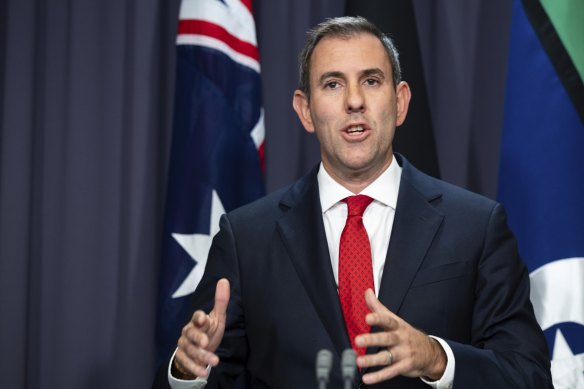Save articles for later
Add articles to your saved list and come back to them any time.
Millions of Australians will miss out on home ownership as the nation heads towards a long period of slow growth in household incomes, forcing more people to fall back on the age pension to pay for shelter.
The trend will put growing pressure on the federal budget, as younger people struggle to get into the housing market, according to a new federal report that says income growth will halve over the next four decades.
Treasurer Jim Chalmers says the country faces a choice between success and complacency this decade.Credit: Alex Ellinghausen
Treasurer Jim Chalmers released the Intergenerational Report on Thursday with a promise to unveil reforms that would lift growth, as the Coalition called on him to reveal his solutions and the Greens demanded more action on housing.
Chalmers said the forecasts should mark the “end of complacency” about the nation’s future, and signalled changes this year to develop more options for people in the drawdown phase of their superannuation, so they could use the income in later life.
The government is also preparing an employment white paper and migration statement to address warnings about labour shortages, but the treasurer dismissed calls for tax reform despite forecasts that the budget would rely more heavily on personal income tax to fund big spending programs.
Home ownership declines
Labor has outlined housing policies including $2 billion for social housing and a $3 billion incentive for states to build more private housing, but the Greens are demanding far greater spending in return for their support for a $10 billion housing fund that is stalled in the Senate.
The Intergenerational Report heightens the dispute over housing by revealing the pressure on the budget as more people head towards retirement without owning homes, forcing them to dip into their super or fall back on the age pension to pay rent.
“The decline in home ownership is most significant for younger age groups,” the report says.
“These trends present a fiscal risk to age pension spending in the future and may impact patterns of how superannuation is drawn down.”
The final report confirms reports by this masthead and others that the nation’s economic growth will fall to 2.2 per cent a year over the next four decades, compared with 3.1 per cent over the past four decades, while climate change will impose vast new costs on the community.
A key measure of household prosperity, real gross national income per person, is forecast to grow by only 1 per cent a year, compared with 2.1 per cent a year over the past four decades.
Australians aged 30 to 34 have already experienced a big fall in home ownership rates. Only 50 per cent in this age bracket owned a home in 2021, compared with 68 per cent in 1981, and the new report shows a similar trend among other age groups.
“Australia’s entire social security system assumes that people will have paid off a mortgage by the time they retire,” said advocacy group Everybody’s Home.
“Our aged care system relies on people’s homes for funding. But more and more people will be renting for life.”
Greens housing spokesman Max Chandler-Mather called on the government to abolish tax breaks for property investors so other buyers could get into the market, citing a costing by the Parliamentary Budget Office that negative gearing and capital gains tax concessions would sacrifice $157 billion in federal revenue over the next decade.
Chandler-Mather called for stricter rent controls and a mass building of public housing, as well as the end to negative gearing. “Those are three policy settings that existed in Australia for large parts of the 20th century after World War II,” he said. ”And those were the policy settings that created high rates of home ownership and much lower levels of housing stress.”
Tax bill climbs
Intergenerational reports, introduced by then treasurer in Peter Costello in 2002, aim to show the impact of population growth, workforce participation and productivity growth on the nation’s finances and society over the coming four decades.
The nation’s median age increased from 30.2 to 38.5 in the past four decades, and is expected to rise to 43.1 years by 2063.
Shadow treasurer Angus Taylor accused the government of releasing the new forecasts without telling people how it would fix the problems.
Asked to name his solutions, Taylor said the government should cut spending and drop the industrial relations changes it plans to unveil next week.
While the government expects a budget surplus of up to $22 billion for the past financial year, the new report predicts deficits in every year to 2063.
One of the reasons for the deficits is increased spending on a range of services.
Government spending per person on the National Disability Insurance Scheme is expected to climb by 237 per cent between now and 2062-63, from $855 to $2879. Spending per person on aged care is tipped to jump by 224 per cent, from $1076 to $3481.
The single largest expense will be health, up by 117 per cent to $8677 per person by the early 2060s. Defence will also eat up more of our taxes, climbing 74 per cent to $3263 per person.
But spending on education will flatline as the ageing population means fewer children and thus less demand for schooling.
By 2062-63, total spending – including on the nation’s interest bill – is forecast to climb from $23,808 per person to $40,162.
As our spending demands increase, the tax system will face substantial challenges.
‘Governments will need to make choices about the structure of the tax system to adapt in the face of this evolving landscape.’
The report notes the tax system will be buffeted by new technologies, decarbonisation, changing consumer spending patterns and an evolving geopolitical outlook, all of which will reshape the economy.
The fuel excise, for instance, will effectively disappear as petrol and diesel-powered vehicles are replaced by electric vehicles.
“Governments will need to make choices about the structure of the tax system to adapt in the face of this evolving landscape, in order to pay for essential public services,” it found.
It notes that without change to the tax mix, personal income tax will account for 58.4 per cent of all tax collected by the Commonwealth, up from 50.5 per cent now. The share of company tax will fall to 18 per cent of the nation’s tax take, from its current level of 23.5 per cent.
The aged care wave
The increased share of income tax will come from a diminishing number of workers.
The “old age dependency ratio”, a measure of the number of people aged over 65 for every 100 people of traditional working age, is expected to jump from 26.6 today to 38.2 in 2062-63.
As the population ages, more people will need health and aged care support paid for by those of working age. At present, just 12 per cent of people over the age of 70, who make up 12.2 per cent of the total population, pay income tax. This group will account for 18.1 per cent of the total population by 2062-63.
Australia’s population is expected to reach 40.5 million by 2062-63, but it will be older and need more health support.Credit: Dan Peled
The report says Australia’s population is expected to grow in line with forecasts produced in the 2021 Intergenerational Report. It expects the population to reach 40.5 million, from its current 26.3 million, by the early 2060s.
The report assumes productivity will grow by 1.2 per cent over the coming decades, in line with the average rate of growth of the past 20 years.
Previous reports used much higher productivity assumptions.
Cut through the noise of federal politics with news, views and expert analysis from Jacqueline Maley. Subscribers can sign up to our weekly Inside Politics newsletter here.
Most Viewed in Politics
From our partners
Source: Read Full Article









